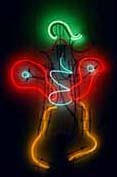Channeling the museumJust as Proteus shifted shapes in order to avoid being pinned down to prophesy the future, digital media's ability to read like text, look like images and video, sound like audio, act like animation, and even behave semi-intelligently conspires to make us think we know what it is; to conflate the future with the past.Even when we acknowledge with the protagonist in Tom Stoppard's play, Arcadia, that "this is the best of all possible times, when everything we thought we knew is wrong," we trip on the apparent isomorphism of digital media and the network. Our information is digital. Our networks are digital. What's the difference? The result is to "channel" the museum via the network, just as it is published in catalogs or aired on television. But no one ever confused a collection catalog with a virtual museum. As Peter Weibel, the new director of the Zentrum fur Kunst und Medientechnologie (ZKM) put it recently: "I would like to make two basic definitions of the virtual museum and what it could be. First of all, it could be a mapping of physically or virtually existing works into physical or virtual spaces. So, we could define it as a mapping of virtual works in a virtual space. I would consider this a valid, legitimate practice for a virtual museum, but it is not 'the real thing.'" |
 What is the difference between media and medium?
au courant a master's thesis exhibition curated by Sarah Cook. "The work of Michel de Broin, Gary Hill, Tatsuo Miyajima and Keith Sonnier questions the place of electricity and electronic circuits in our daily lives." Peter Weibel, The virtual museum: beyond the white cube: art any time any place.
|